Ethical Decision Making Assessment 2022
VerifiedAdded on 2022/09/15
|13
|2912
|14
AI Summary
Contribute Materials
Your contribution can guide someone’s learning journey. Share your
documents today.

“Faculty of Health Sciences”
“Assessment 2 - Ethical Decision Making”
“Name of the Student”
“Student ID”
“Name of the University”
1
“Assessment 2 - Ethical Decision Making”
“Name of the Student”
“Student ID”
“Name of the University”
1
Secure Best Marks with AI Grader
Need help grading? Try our AI Grader for instant feedback on your assignments.

“Faculty of Health Sciences”
“Assessment 2 - Ethical Decision Making”
1. Introduction
Violence and aggression are an environment in which health workers often feel insecure.
An aggressive, abusive or violent patient may be uncomfortable. But in acute medical
conditions, it is more probable that this abnormal behaviour is due to a mental or
emotional condition, or both (Connell, Brazier, O’Cathain, Lloyd-Jones & Paisley, 2012).
We can presume that the irregular behaviour of the patient is the manifestation of mental
agony or unsatisfactory needs. By knowing why they are created, identifying the need
and attempting to anticipate or satisfy it we can control or prevent such situation to occur.
The challenging behaviour under these circumstances is similar to any other issue,
diagnostic and treatment are the medical strategy while maintaining safety and function
("Overview | Violence and aggression: short-term management in mental health, health
and community settings | Guidance | NICE", 2015). In addition, the person-centric
strategy to emotional and psychological distress understanding and addressing is
necessary. Competent communication, no confrontation, relationship building and
negotiation are the best way to handle situations and avoid harm to take place.
2. Identification of the facts.
The cause for unrest in the patient's behavior consists of a combination of variables
inherent in the patient including personalities, physical symptoms, or serious mental
distress, as well as external variables, e.g. attitudes or behavior of employees and others
("Preventing Workplace Violence: The Occupational and Environmental Health Nurse
Role", 2014). Patients should follow basic behavioral norms in hospitals or nursing
2
“Assessment 2 - Ethical Decision Making”
1. Introduction
Violence and aggression are an environment in which health workers often feel insecure.
An aggressive, abusive or violent patient may be uncomfortable. But in acute medical
conditions, it is more probable that this abnormal behaviour is due to a mental or
emotional condition, or both (Connell, Brazier, O’Cathain, Lloyd-Jones & Paisley, 2012).
We can presume that the irregular behaviour of the patient is the manifestation of mental
agony or unsatisfactory needs. By knowing why they are created, identifying the need
and attempting to anticipate or satisfy it we can control or prevent such situation to occur.
The challenging behaviour under these circumstances is similar to any other issue,
diagnostic and treatment are the medical strategy while maintaining safety and function
("Overview | Violence and aggression: short-term management in mental health, health
and community settings | Guidance | NICE", 2015). In addition, the person-centric
strategy to emotional and psychological distress understanding and addressing is
necessary. Competent communication, no confrontation, relationship building and
negotiation are the best way to handle situations and avoid harm to take place.
2. Identification of the facts.
The cause for unrest in the patient's behavior consists of a combination of variables
inherent in the patient including personalities, physical symptoms, or serious mental
distress, as well as external variables, e.g. attitudes or behavior of employees and others
("Preventing Workplace Violence: The Occupational and Environmental Health Nurse
Role", 2014). Patients should follow basic behavioral norms in hospitals or nursing
2
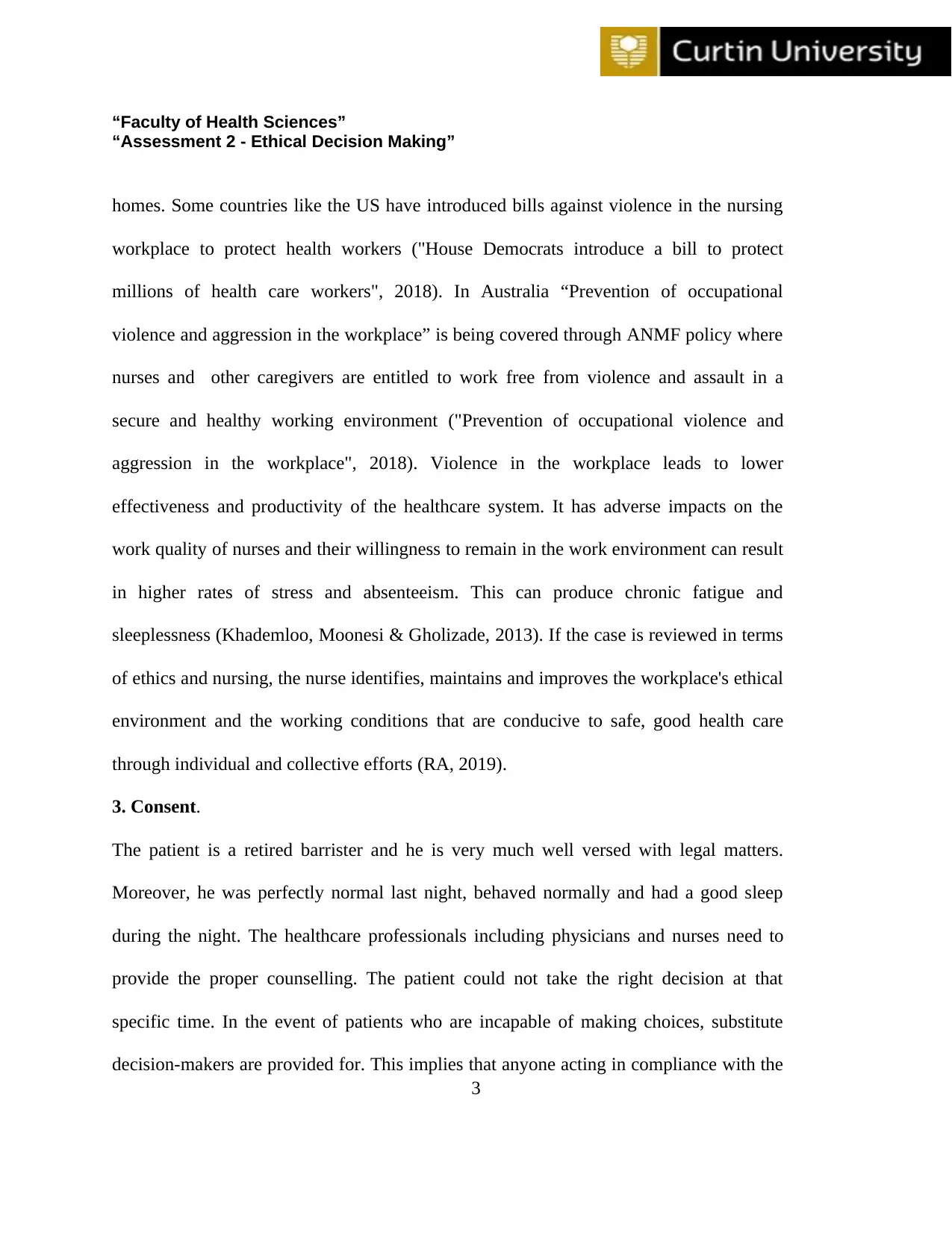
“Faculty of Health Sciences”
“Assessment 2 - Ethical Decision Making”
homes. Some countries like the US have introduced bills against violence in the nursing
workplace to protect health workers ("House Democrats introduce a bill to protect
millions of health care workers", 2018). In Australia “Prevention of occupational
violence and aggression in the workplace” is being covered through ANMF policy where
nurses and other caregivers are entitled to work free from violence and assault in a
secure and healthy working environment ("Prevention of occupational violence and
aggression in the workplace", 2018). Violence in the workplace leads to lower
effectiveness and productivity of the healthcare system. It has adverse impacts on the
work quality of nurses and their willingness to remain in the work environment can result
in higher rates of stress and absenteeism. This can produce chronic fatigue and
sleeplessness (Khademloo, Moonesi & Gholizade, 2013). If the case is reviewed in terms
of ethics and nursing, the nurse identifies, maintains and improves the workplace's ethical
environment and the working conditions that are conducive to safe, good health care
through individual and collective efforts (RA, 2019).
3. Consent.
The patient is a retired barrister and he is very much well versed with legal matters.
Moreover, he was perfectly normal last night, behaved normally and had a good sleep
during the night. The healthcare professionals including physicians and nurses need to
provide the proper counselling. The patient could not take the right decision at that
specific time. In the event of patients who are incapable of making choices, substitute
decision-makers are provided for. This implies that anyone acting in compliance with the
3
“Assessment 2 - Ethical Decision Making”
homes. Some countries like the US have introduced bills against violence in the nursing
workplace to protect health workers ("House Democrats introduce a bill to protect
millions of health care workers", 2018). In Australia “Prevention of occupational
violence and aggression in the workplace” is being covered through ANMF policy where
nurses and other caregivers are entitled to work free from violence and assault in a
secure and healthy working environment ("Prevention of occupational violence and
aggression in the workplace", 2018). Violence in the workplace leads to lower
effectiveness and productivity of the healthcare system. It has adverse impacts on the
work quality of nurses and their willingness to remain in the work environment can result
in higher rates of stress and absenteeism. This can produce chronic fatigue and
sleeplessness (Khademloo, Moonesi & Gholizade, 2013). If the case is reviewed in terms
of ethics and nursing, the nurse identifies, maintains and improves the workplace's ethical
environment and the working conditions that are conducive to safe, good health care
through individual and collective efforts (RA, 2019).
3. Consent.
The patient is a retired barrister and he is very much well versed with legal matters.
Moreover, he was perfectly normal last night, behaved normally and had a good sleep
during the night. The healthcare professionals including physicians and nurses need to
provide the proper counselling. The patient could not take the right decision at that
specific time. In the event of patients who are incapable of making choices, substitute
decision-makers are provided for. This implies that anyone acting in compliance with the
3

“Faculty of Health Sciences”
“Assessment 2 - Ethical Decision Making”
delegation of power as a duly-empowered substitute decision-maker has to act. Since this
delegation is eventually based on the principle of equality and justice, it implies that
alternative decision-makers must take action within the parameters of the equality and
justice ("Ethics for healthcare professionals informatics", 2016). Therefore, it should only
work as a replacement decision-maker for someone who makes health care choices that
conform to existent held values of the incompetent one (Dresser, 2014).
4. Legal Issues
As the patient cannot make a correct decision, the hospital must resort to legal
alternatives to continue medical treatment. The hospital has to take opinion from
surrogate decision-maker on behalf of the patient who should be appointed legally (e.g.
court-ordered guardian) or next kin (if no prior directive is in place) (White et al., 2017).
The provision is supported by the Australian Charter of Health Rights which the
Australian Commission on Health Care Safety and Quality established and adopted by all
the Health Ministers in 2008. These rights are vital to guarantee that all individuals, in all
Australian medical conditions ("Australian Charter of Health Rights", 2009), are
provided with secure and good quality care. There is a separate law in each State and
territory of Australia to monitor the appointment of an alternate decision-maker for
adolescents 18 years and older. The main laws in Victoria are: “Powers of Attorney Act
2014” which may allow an attorney to be appointed for private or monetary matters
("Substitute Decision Taking in Victoria and Law", 2017) and “Guardianship and
4
“Assessment 2 - Ethical Decision Making”
delegation of power as a duly-empowered substitute decision-maker has to act. Since this
delegation is eventually based on the principle of equality and justice, it implies that
alternative decision-makers must take action within the parameters of the equality and
justice ("Ethics for healthcare professionals informatics", 2016). Therefore, it should only
work as a replacement decision-maker for someone who makes health care choices that
conform to existent held values of the incompetent one (Dresser, 2014).
4. Legal Issues
As the patient cannot make a correct decision, the hospital must resort to legal
alternatives to continue medical treatment. The hospital has to take opinion from
surrogate decision-maker on behalf of the patient who should be appointed legally (e.g.
court-ordered guardian) or next kin (if no prior directive is in place) (White et al., 2017).
The provision is supported by the Australian Charter of Health Rights which the
Australian Commission on Health Care Safety and Quality established and adopted by all
the Health Ministers in 2008. These rights are vital to guarantee that all individuals, in all
Australian medical conditions ("Australian Charter of Health Rights", 2009), are
provided with secure and good quality care. There is a separate law in each State and
territory of Australia to monitor the appointment of an alternate decision-maker for
adolescents 18 years and older. The main laws in Victoria are: “Powers of Attorney Act
2014” which may allow an attorney to be appointed for private or monetary matters
("Substitute Decision Taking in Victoria and Law", 2017) and “Guardianship and
4
Secure Best Marks with AI Grader
Need help grading? Try our AI Grader for instant feedback on your assignments.

“Faculty of Health Sciences”
“Assessment 2 - Ethical Decision Making”
Administration Act 1986 - VCAT (also known as The Tribunal)” can appoint guardians
and/or administrators ("Substitute decision making in Victoria and the law", 2017).
5. Ethical Issues
Health practitioners are accountable for the achievement of objectives of health services,
curing diseases and alleviating suffering. Certain principles of ethics can guide their
objectives. In this particular case, the patient has lost his capacity to decide and creates a
scenario in which the nurse finds that continuing care is near impossible. The following
six ethical questions are described, such as “beneficence, non-maleficence, autonomy,
justice, veracity, confidentiality” are applied. ("Ethical Challenges in Medical Decision
Making", 2012).
a. Beneficence: Beneficence assumes liability for improving the patient's well-being
("SAMHSA–Administration of Substance Mismanagement and Mental Health Services",
2016). As the nurse cannot regulate the patient, she did the correct thing in this situation
by asking their peers for assistance, and a combined effort could persuade the patient to
acknowledge the healthcare.
b. Non-maleficence: It means not to do any harm. The concept of non-maleficence is that
we do not hurt our patients deliberately or unwittingly, for example, without leaving a
patient who needs our services ("OLCreate: HEAT_HMER_ET_1.0 Health
Management, Ethics and Research Module: 7. Principles of Healthcare Ethics:
7.2.4 Beneficence and non-maleficence", 2019). Though the patient is not in a normal
sense and not allowing the nurse to do the cleaning work which may cause infection in
5
“Assessment 2 - Ethical Decision Making”
Administration Act 1986 - VCAT (also known as The Tribunal)” can appoint guardians
and/or administrators ("Substitute decision making in Victoria and the law", 2017).
5. Ethical Issues
Health practitioners are accountable for the achievement of objectives of health services,
curing diseases and alleviating suffering. Certain principles of ethics can guide their
objectives. In this particular case, the patient has lost his capacity to decide and creates a
scenario in which the nurse finds that continuing care is near impossible. The following
six ethical questions are described, such as “beneficence, non-maleficence, autonomy,
justice, veracity, confidentiality” are applied. ("Ethical Challenges in Medical Decision
Making", 2012).
a. Beneficence: Beneficence assumes liability for improving the patient's well-being
("SAMHSA–Administration of Substance Mismanagement and Mental Health Services",
2016). As the nurse cannot regulate the patient, she did the correct thing in this situation
by asking their peers for assistance, and a combined effort could persuade the patient to
acknowledge the healthcare.
b. Non-maleficence: It means not to do any harm. The concept of non-maleficence is that
we do not hurt our patients deliberately or unwittingly, for example, without leaving a
patient who needs our services ("OLCreate: HEAT_HMER_ET_1.0 Health
Management, Ethics and Research Module: 7. Principles of Healthcare Ethics:
7.2.4 Beneficence and non-maleficence", 2019). Though the patient is not in a normal
sense and not allowing the nurse to do the cleaning work which may cause infection in
5
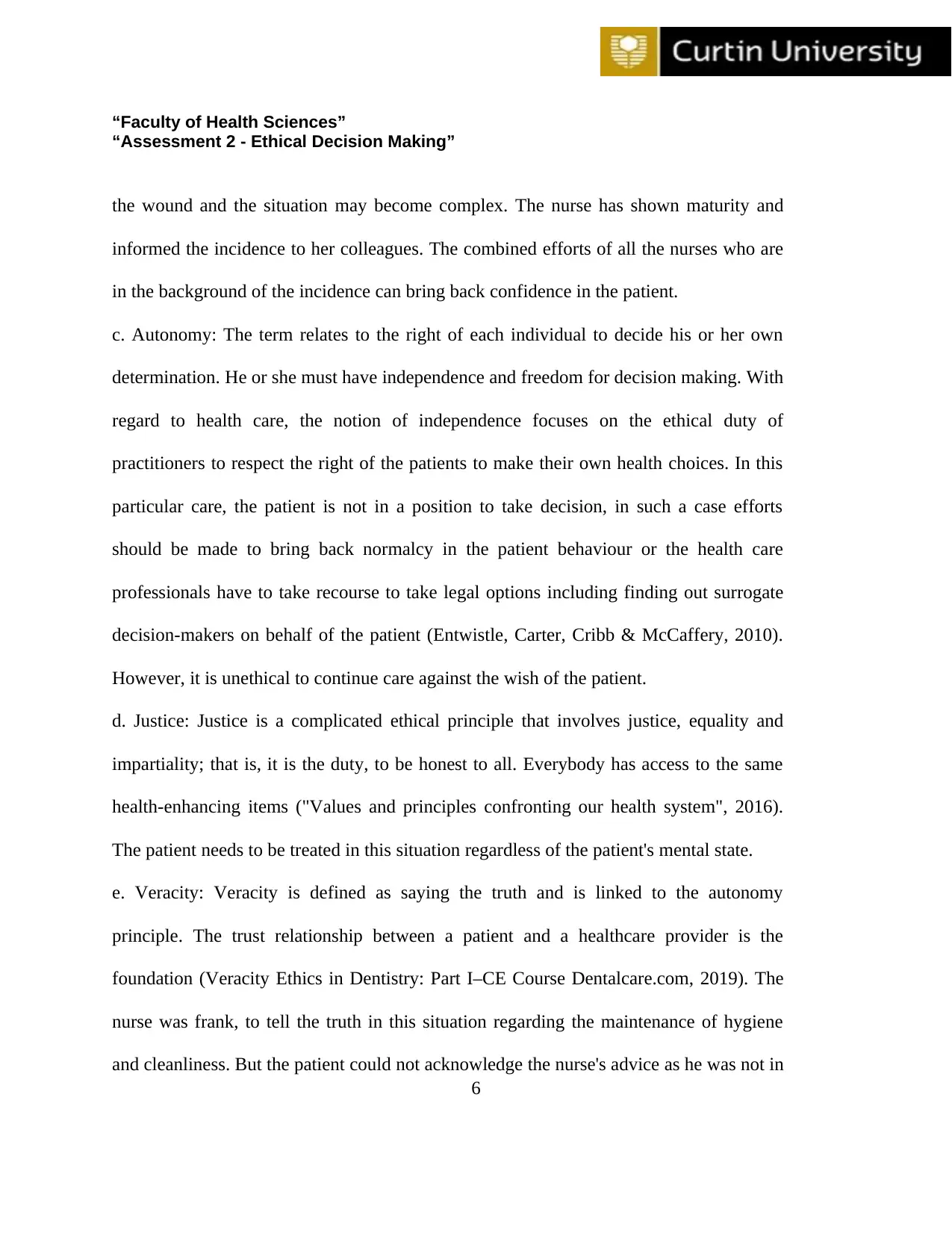
“Faculty of Health Sciences”
“Assessment 2 - Ethical Decision Making”
the wound and the situation may become complex. The nurse has shown maturity and
informed the incidence to her colleagues. The combined efforts of all the nurses who are
in the background of the incidence can bring back confidence in the patient.
c. Autonomy: The term relates to the right of each individual to decide his or her own
determination. He or she must have independence and freedom for decision making. With
regard to health care, the notion of independence focuses on the ethical duty of
practitioners to respect the right of the patients to make their own health choices. In this
particular care, the patient is not in a position to take decision, in such a case efforts
should be made to bring back normalcy in the patient behaviour or the health care
professionals have to take recourse to take legal options including finding out surrogate
decision-makers on behalf of the patient (Entwistle, Carter, Cribb & McCaffery, 2010).
However, it is unethical to continue care against the wish of the patient.
d. Justice: Justice is a complicated ethical principle that involves justice, equality and
impartiality; that is, it is the duty, to be honest to all. Everybody has access to the same
health-enhancing items ("Values and principles confronting our health system", 2016).
The patient needs to be treated in this situation regardless of the patient's mental state.
e. Veracity: Veracity is defined as saying the truth and is linked to the autonomy
principle. The trust relationship between a patient and a healthcare provider is the
foundation (Veracity Ethics in Dentistry: Part I–CE Course Dentalcare.com, 2019). The
nurse was frank, to tell the truth in this situation regarding the maintenance of hygiene
and cleanliness. But the patient could not acknowledge the nurse's advice as he was not in
6
“Assessment 2 - Ethical Decision Making”
the wound and the situation may become complex. The nurse has shown maturity and
informed the incidence to her colleagues. The combined efforts of all the nurses who are
in the background of the incidence can bring back confidence in the patient.
c. Autonomy: The term relates to the right of each individual to decide his or her own
determination. He or she must have independence and freedom for decision making. With
regard to health care, the notion of independence focuses on the ethical duty of
practitioners to respect the right of the patients to make their own health choices. In this
particular care, the patient is not in a position to take decision, in such a case efforts
should be made to bring back normalcy in the patient behaviour or the health care
professionals have to take recourse to take legal options including finding out surrogate
decision-makers on behalf of the patient (Entwistle, Carter, Cribb & McCaffery, 2010).
However, it is unethical to continue care against the wish of the patient.
d. Justice: Justice is a complicated ethical principle that involves justice, equality and
impartiality; that is, it is the duty, to be honest to all. Everybody has access to the same
health-enhancing items ("Values and principles confronting our health system", 2016).
The patient needs to be treated in this situation regardless of the patient's mental state.
e. Veracity: Veracity is defined as saying the truth and is linked to the autonomy
principle. The trust relationship between a patient and a healthcare provider is the
foundation (Veracity Ethics in Dentistry: Part I–CE Course Dentalcare.com, 2019). The
nurse was frank, to tell the truth in this situation regarding the maintenance of hygiene
and cleanliness. But the patient could not acknowledge the nurse's advice as he was not in
6

“Faculty of Health Sciences”
“Assessment 2 - Ethical Decision Making”
a mental position to do so. The nurse did its utmost to inform her colleagues about the
matter in order to work together to resolve the matter.
f. Confidentiality: In circumstances involving a significant risk of considerable damage to
the health or safety of the patient or others the nurse has an ethical obligation to disclose
facts. In this case, caregivers use an ethical decision-making mechanism prior to
disclosure. In this process, consultation with competent peers is required whenever
possible. In this case study, the nurse is facing an ethical dilemma on two ethical
principles, beneficence and autonomy which have been already discussed.
6. Professional Issues
The patient is at the core of the healthcare profession. It's only a circumstance that the
patient behaves abnormally and doesn't change how the nurse operates or how the nurse
views the patient ("Preventing Workplace Violence: The Occupational and
Environmental Health Nurse Role", 2014). Patient care is subject to the nursing code of
conduct, the code of ethics, the practice standards of registered nurses and NSQHS
standards in any situation. A succinct statement of the ethical values, principles and
responsibilities of any person who enters into the nursing profession is provided in the
nursing Code of Ethics. The skilled level of care in each stage of the care process is
described in professional norms. The primary aim of the professional norms is to manage
and retain health care practices which are secure and clinically qualified. The main
objective of the NSQHS standards is to protect the public against harm and improve
health services quality (Twigg, Duffield & Evans, 2013). They provide a mechanism for
7
“Assessment 2 - Ethical Decision Making”
a mental position to do so. The nurse did its utmost to inform her colleagues about the
matter in order to work together to resolve the matter.
f. Confidentiality: In circumstances involving a significant risk of considerable damage to
the health or safety of the patient or others the nurse has an ethical obligation to disclose
facts. In this case, caregivers use an ethical decision-making mechanism prior to
disclosure. In this process, consultation with competent peers is required whenever
possible. In this case study, the nurse is facing an ethical dilemma on two ethical
principles, beneficence and autonomy which have been already discussed.
6. Professional Issues
The patient is at the core of the healthcare profession. It's only a circumstance that the
patient behaves abnormally and doesn't change how the nurse operates or how the nurse
views the patient ("Preventing Workplace Violence: The Occupational and
Environmental Health Nurse Role", 2014). Patient care is subject to the nursing code of
conduct, the code of ethics, the practice standards of registered nurses and NSQHS
standards in any situation. A succinct statement of the ethical values, principles and
responsibilities of any person who enters into the nursing profession is provided in the
nursing Code of Ethics. The skilled level of care in each stage of the care process is
described in professional norms. The primary aim of the professional norms is to manage
and retain health care practices which are secure and clinically qualified. The main
objective of the NSQHS standards is to protect the public against harm and improve
health services quality (Twigg, Duffield & Evans, 2013). They provide a mechanism for
7
Paraphrase This Document
Need a fresh take? Get an instant paraphrase of this document with our AI Paraphraser

“Faculty of Health Sciences”
“Assessment 2 - Ethical Decision Making”
quality assurance which tests the availability of appropriate technologies to guarantee that
expected security and quality standards are fulfilled. NSQHS is based on eight Standards,
covering healthcare-related infections, high-prevalence adverse incidences , safety of
medication, clinical communication, comprehensive care, the management and
prevention of pressure injuries, the falls prevention and responding to clinical
deterioration ("National Safety and Quality Health Service Standards", 2017). To
preserve safety and quality standards, the nurses should make a concerted effort to
persuade the patient and to begin regular treatment to ensure that the wound in the
abdomen does not become infected. Documentation is essential, particularly if something
goes wrong (Manias, Geddes, Watson, Jones & Della, 2015). The rationale and measures
for non-pharmacological de-escalation should ideally be documented, and an incident
should also be followed by a formal employee brief, otherwise, speak to peers or present
the case at a clinical conference (Harwood, 2017).
7. Conclusion
If patients are distressed, anxious, afraid, unable to say anything to anyone, they can be
challenging. Clinically linked, difficult behaviour, however, is prevalent in healthcare
environments. If the challenge is not properly resolved, the capacity of employees to
provide high-quality, proper care can be impaired. It can also lead to over-reliance in
employees and patients on restrictive physical and pharmacological measures, mental ill-
health and physical accidents. The student nurse called for help from senior nurses who
have the experience to deal with this kind of situation and the team of nurses should
8
“Assessment 2 - Ethical Decision Making”
quality assurance which tests the availability of appropriate technologies to guarantee that
expected security and quality standards are fulfilled. NSQHS is based on eight Standards,
covering healthcare-related infections, high-prevalence adverse incidences , safety of
medication, clinical communication, comprehensive care, the management and
prevention of pressure injuries, the falls prevention and responding to clinical
deterioration ("National Safety and Quality Health Service Standards", 2017). To
preserve safety and quality standards, the nurses should make a concerted effort to
persuade the patient and to begin regular treatment to ensure that the wound in the
abdomen does not become infected. Documentation is essential, particularly if something
goes wrong (Manias, Geddes, Watson, Jones & Della, 2015). The rationale and measures
for non-pharmacological de-escalation should ideally be documented, and an incident
should also be followed by a formal employee brief, otherwise, speak to peers or present
the case at a clinical conference (Harwood, 2017).
7. Conclusion
If patients are distressed, anxious, afraid, unable to say anything to anyone, they can be
challenging. Clinically linked, difficult behaviour, however, is prevalent in healthcare
environments. If the challenge is not properly resolved, the capacity of employees to
provide high-quality, proper care can be impaired. It can also lead to over-reliance in
employees and patients on restrictive physical and pharmacological measures, mental ill-
health and physical accidents. The student nurse called for help from senior nurses who
have the experience to deal with this kind of situation and the team of nurses should
8
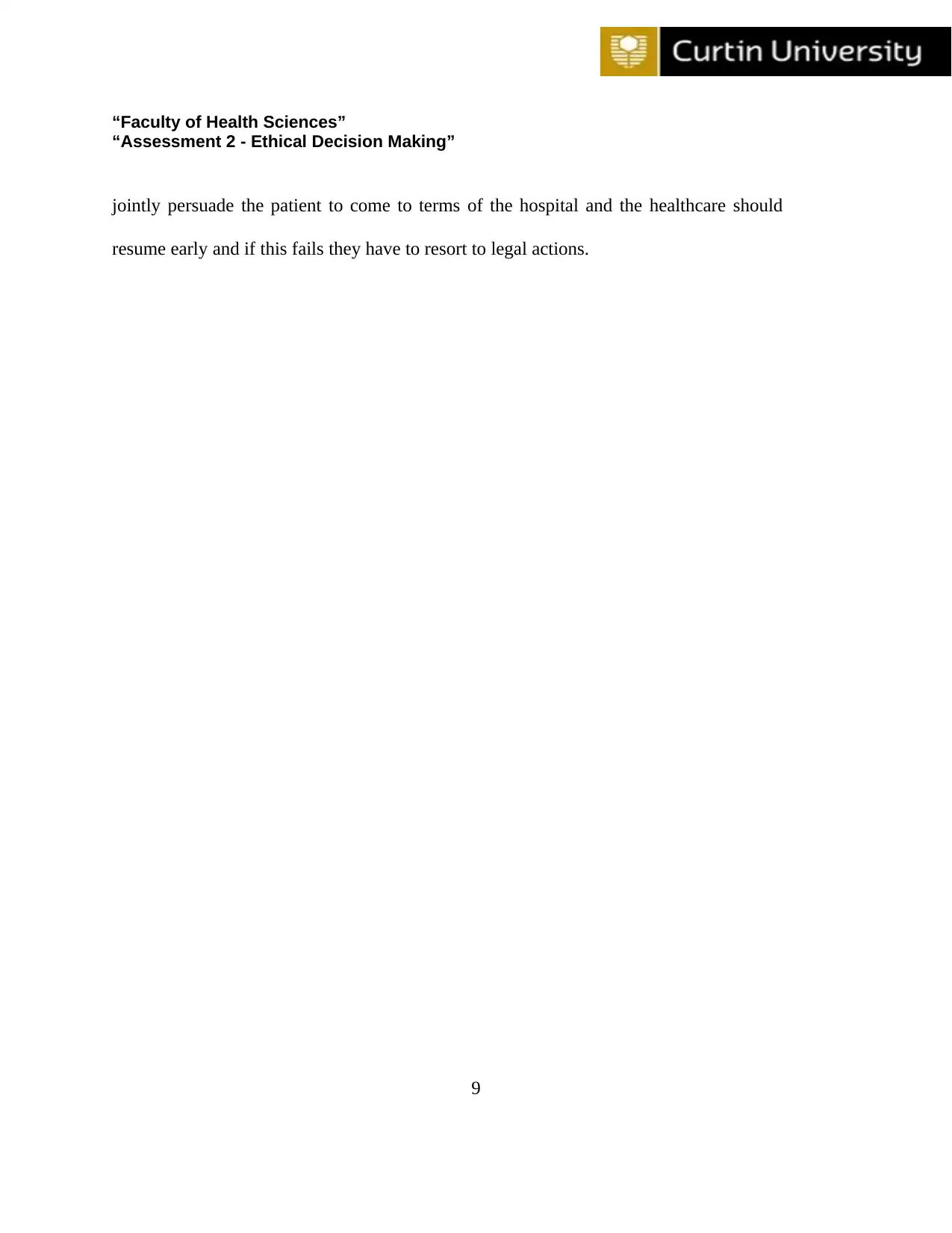
“Faculty of Health Sciences”
“Assessment 2 - Ethical Decision Making”
jointly persuade the patient to come to terms of the hospital and the healthcare should
resume early and if this fails they have to resort to legal actions.
9
“Assessment 2 - Ethical Decision Making”
jointly persuade the patient to come to terms of the hospital and the healthcare should
resume early and if this fails they have to resort to legal actions.
9
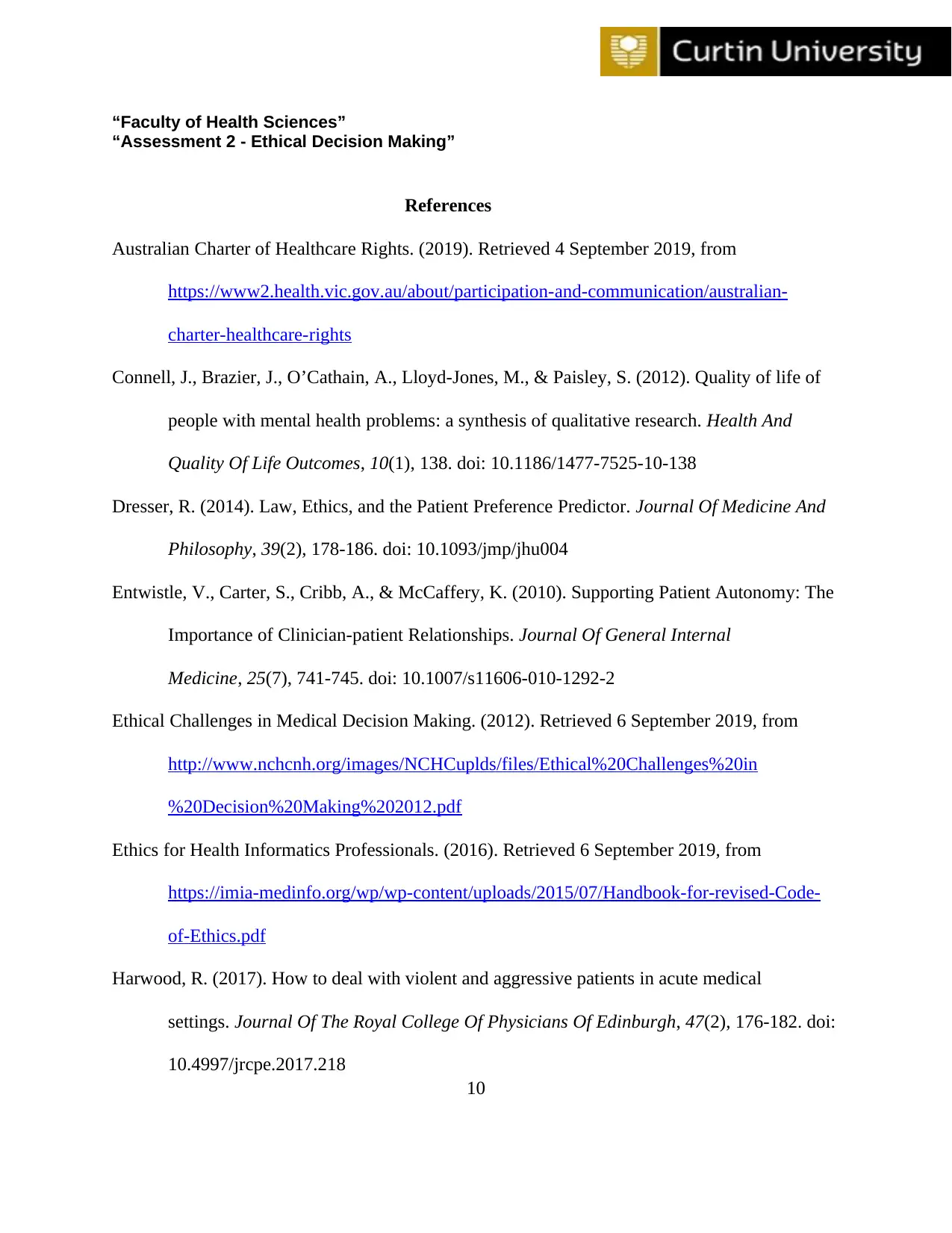
“Faculty of Health Sciences”
“Assessment 2 - Ethical Decision Making”
References
Australian Charter of Healthcare Rights. (2019). Retrieved 4 September 2019, from
https://www2.health.vic.gov.au/about/participation-and-communication/australian-
charter-healthcare-rights
Connell, J., Brazier, J., O’Cathain, A., Lloyd-Jones, M., & Paisley, S. (2012). Quality of life of
people with mental health problems: a synthesis of qualitative research. Health And
Quality Of Life Outcomes, 10(1), 138. doi: 10.1186/1477-7525-10-138
Dresser, R. (2014). Law, Ethics, and the Patient Preference Predictor. Journal Of Medicine And
Philosophy, 39(2), 178-186. doi: 10.1093/jmp/jhu004
Entwistle, V., Carter, S., Cribb, A., & McCaffery, K. (2010). Supporting Patient Autonomy: The
Importance of Clinician-patient Relationships. Journal Of General Internal
Medicine, 25(7), 741-745. doi: 10.1007/s11606-010-1292-2
Ethical Challenges in Medical Decision Making. (2012). Retrieved 6 September 2019, from
http://www.nchcnh.org/images/NCHCuplds/files/Ethical%20Challenges%20in
%20Decision%20Making%202012.pdf
Ethics for Health Informatics Professionals. (2016). Retrieved 6 September 2019, from
https://imia-medinfo.org/wp/wp-content/uploads/2015/07/Handbook-for-revised-Code-
of-Ethics.pdf
Harwood, R. (2017). How to deal with violent and aggressive patients in acute medical
settings. Journal Of The Royal College Of Physicians Of Edinburgh, 47(2), 176-182. doi:
10.4997/jrcpe.2017.218
10
“Assessment 2 - Ethical Decision Making”
References
Australian Charter of Healthcare Rights. (2019). Retrieved 4 September 2019, from
https://www2.health.vic.gov.au/about/participation-and-communication/australian-
charter-healthcare-rights
Connell, J., Brazier, J., O’Cathain, A., Lloyd-Jones, M., & Paisley, S. (2012). Quality of life of
people with mental health problems: a synthesis of qualitative research. Health And
Quality Of Life Outcomes, 10(1), 138. doi: 10.1186/1477-7525-10-138
Dresser, R. (2014). Law, Ethics, and the Patient Preference Predictor. Journal Of Medicine And
Philosophy, 39(2), 178-186. doi: 10.1093/jmp/jhu004
Entwistle, V., Carter, S., Cribb, A., & McCaffery, K. (2010). Supporting Patient Autonomy: The
Importance of Clinician-patient Relationships. Journal Of General Internal
Medicine, 25(7), 741-745. doi: 10.1007/s11606-010-1292-2
Ethical Challenges in Medical Decision Making. (2012). Retrieved 6 September 2019, from
http://www.nchcnh.org/images/NCHCuplds/files/Ethical%20Challenges%20in
%20Decision%20Making%202012.pdf
Ethics for Health Informatics Professionals. (2016). Retrieved 6 September 2019, from
https://imia-medinfo.org/wp/wp-content/uploads/2015/07/Handbook-for-revised-Code-
of-Ethics.pdf
Harwood, R. (2017). How to deal with violent and aggressive patients in acute medical
settings. Journal Of The Royal College Of Physicians Of Edinburgh, 47(2), 176-182. doi:
10.4997/jrcpe.2017.218
10
Secure Best Marks with AI Grader
Need help grading? Try our AI Grader for instant feedback on your assignments.
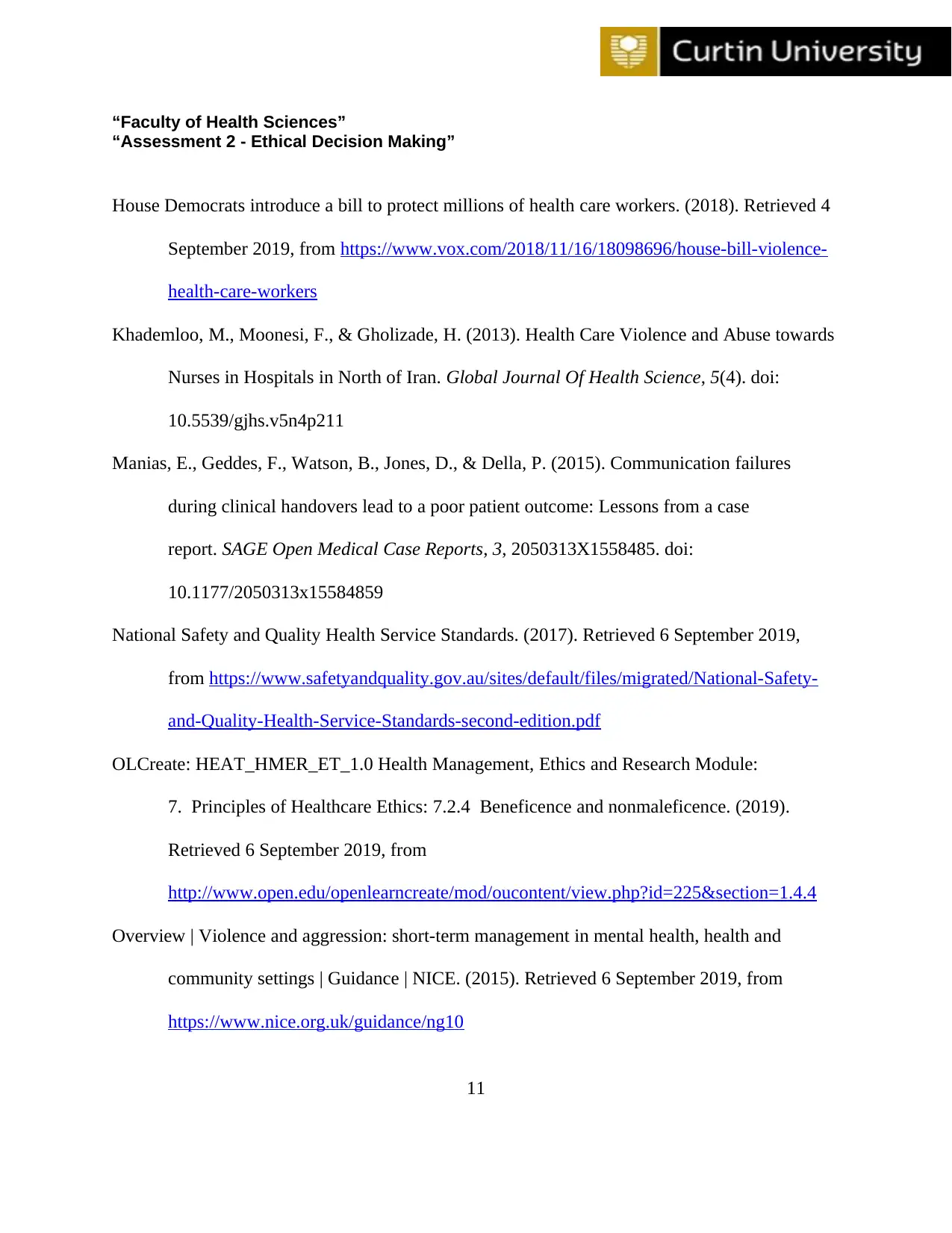
“Faculty of Health Sciences”
“Assessment 2 - Ethical Decision Making”
House Democrats introduce a bill to protect millions of health care workers. (2018). Retrieved 4
September 2019, from https://www.vox.com/2018/11/16/18098696/house-bill-violence-
health-care-workers
Khademloo, M., Moonesi, F., & Gholizade, H. (2013). Health Care Violence and Abuse towards
Nurses in Hospitals in North of Iran. Global Journal Of Health Science, 5(4). doi:
10.5539/gjhs.v5n4p211
Manias, E., Geddes, F., Watson, B., Jones, D., & Della, P. (2015). Communication failures
during clinical handovers lead to a poor patient outcome: Lessons from a case
report. SAGE Open Medical Case Reports, 3, 2050313X1558485. doi:
10.1177/2050313x15584859
National Safety and Quality Health Service Standards. (2017). Retrieved 6 September 2019,
from https://www.safetyandquality.gov.au/sites/default/files/migrated/National-Safety-
and-Quality-Health-Service-Standards-second-edition.pdf
OLCreate: HEAT_HMER_ET_1.0 Health Management, Ethics and Research Module:
7. Principles of Healthcare Ethics: 7.2.4 Beneficence and nonmaleficence. (2019).
Retrieved 6 September 2019, from
http://www.open.edu/openlearncreate/mod/oucontent/view.php?id=225§ion=1.4.4
Overview | Violence and aggression: short-term management in mental health, health and
community settings | Guidance | NICE. (2015). Retrieved 6 September 2019, from
https://www.nice.org.uk/guidance/ng10
11
“Assessment 2 - Ethical Decision Making”
House Democrats introduce a bill to protect millions of health care workers. (2018). Retrieved 4
September 2019, from https://www.vox.com/2018/11/16/18098696/house-bill-violence-
health-care-workers
Khademloo, M., Moonesi, F., & Gholizade, H. (2013). Health Care Violence and Abuse towards
Nurses in Hospitals in North of Iran. Global Journal Of Health Science, 5(4). doi:
10.5539/gjhs.v5n4p211
Manias, E., Geddes, F., Watson, B., Jones, D., & Della, P. (2015). Communication failures
during clinical handovers lead to a poor patient outcome: Lessons from a case
report. SAGE Open Medical Case Reports, 3, 2050313X1558485. doi:
10.1177/2050313x15584859
National Safety and Quality Health Service Standards. (2017). Retrieved 6 September 2019,
from https://www.safetyandquality.gov.au/sites/default/files/migrated/National-Safety-
and-Quality-Health-Service-Standards-second-edition.pdf
OLCreate: HEAT_HMER_ET_1.0 Health Management, Ethics and Research Module:
7. Principles of Healthcare Ethics: 7.2.4 Beneficence and nonmaleficence. (2019).
Retrieved 6 September 2019, from
http://www.open.edu/openlearncreate/mod/oucontent/view.php?id=225§ion=1.4.4
Overview | Violence and aggression: short-term management in mental health, health and
community settings | Guidance | NICE. (2015). Retrieved 6 September 2019, from
https://www.nice.org.uk/guidance/ng10
11
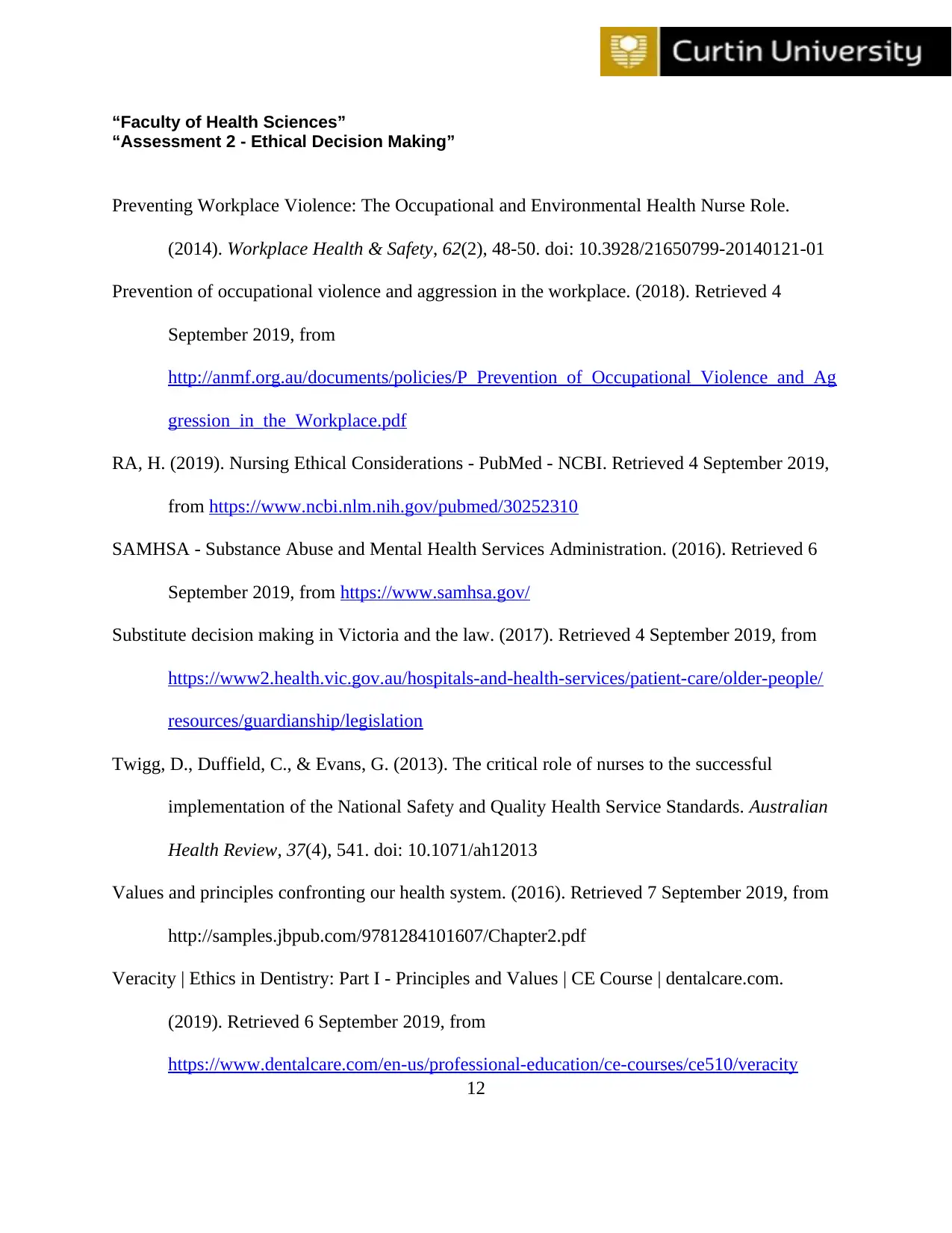
“Faculty of Health Sciences”
“Assessment 2 - Ethical Decision Making”
Preventing Workplace Violence: The Occupational and Environmental Health Nurse Role.
(2014). Workplace Health & Safety, 62(2), 48-50. doi: 10.3928/21650799-20140121-01
Prevention of occupational violence and aggression in the workplace. (2018). Retrieved 4
September 2019, from
http://anmf.org.au/documents/policies/P_Prevention_of_Occupational_Violence_and_Ag
gression_in_the_Workplace.pdf
RA, H. (2019). Nursing Ethical Considerations - PubMed - NCBI. Retrieved 4 September 2019,
from https://www.ncbi.nlm.nih.gov/pubmed/30252310
SAMHSA - Substance Abuse and Mental Health Services Administration. (2016). Retrieved 6
September 2019, from https://www.samhsa.gov/
Substitute decision making in Victoria and the law. (2017). Retrieved 4 September 2019, from
https://www2.health.vic.gov.au/hospitals-and-health-services/patient-care/older-people/
resources/guardianship/legislation
Twigg, D., Duffield, C., & Evans, G. (2013). The critical role of nurses to the successful
implementation of the National Safety and Quality Health Service Standards. Australian
Health Review, 37(4), 541. doi: 10.1071/ah12013
Values and principles confronting our health system. (2016). Retrieved 7 September 2019, from
http://samples.jbpub.com/9781284101607/Chapter2.pdf
Veracity | Ethics in Dentistry: Part I - Principles and Values | CE Course | dentalcare.com.
(2019). Retrieved 6 September 2019, from
https://www.dentalcare.com/en-us/professional-education/ce-courses/ce510/veracity
12
“Assessment 2 - Ethical Decision Making”
Preventing Workplace Violence: The Occupational and Environmental Health Nurse Role.
(2014). Workplace Health & Safety, 62(2), 48-50. doi: 10.3928/21650799-20140121-01
Prevention of occupational violence and aggression in the workplace. (2018). Retrieved 4
September 2019, from
http://anmf.org.au/documents/policies/P_Prevention_of_Occupational_Violence_and_Ag
gression_in_the_Workplace.pdf
RA, H. (2019). Nursing Ethical Considerations - PubMed - NCBI. Retrieved 4 September 2019,
from https://www.ncbi.nlm.nih.gov/pubmed/30252310
SAMHSA - Substance Abuse and Mental Health Services Administration. (2016). Retrieved 6
September 2019, from https://www.samhsa.gov/
Substitute decision making in Victoria and the law. (2017). Retrieved 4 September 2019, from
https://www2.health.vic.gov.au/hospitals-and-health-services/patient-care/older-people/
resources/guardianship/legislation
Twigg, D., Duffield, C., & Evans, G. (2013). The critical role of nurses to the successful
implementation of the National Safety and Quality Health Service Standards. Australian
Health Review, 37(4), 541. doi: 10.1071/ah12013
Values and principles confronting our health system. (2016). Retrieved 7 September 2019, from
http://samples.jbpub.com/9781284101607/Chapter2.pdf
Veracity | Ethics in Dentistry: Part I - Principles and Values | CE Course | dentalcare.com.
(2019). Retrieved 6 September 2019, from
https://www.dentalcare.com/en-us/professional-education/ce-courses/ce510/veracity
12
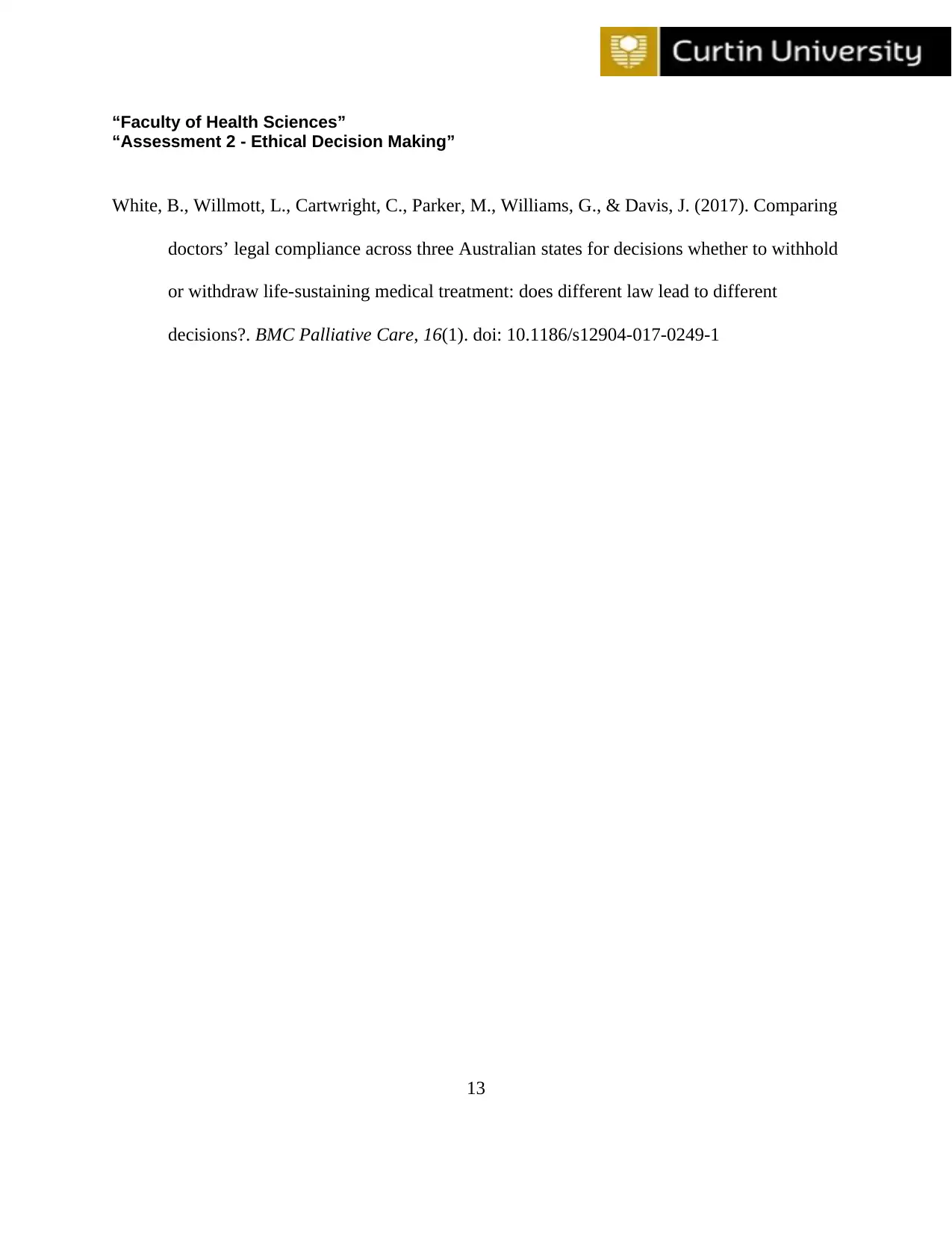
“Faculty of Health Sciences”
“Assessment 2 - Ethical Decision Making”
White, B., Willmott, L., Cartwright, C., Parker, M., Williams, G., & Davis, J. (2017). Comparing
doctors’ legal compliance across three Australian states for decisions whether to withhold
or withdraw life-sustaining medical treatment: does different law lead to different
decisions?. BMC Palliative Care, 16(1). doi: 10.1186/s12904-017-0249-1
13
“Assessment 2 - Ethical Decision Making”
White, B., Willmott, L., Cartwright, C., Parker, M., Williams, G., & Davis, J. (2017). Comparing
doctors’ legal compliance across three Australian states for decisions whether to withhold
or withdraw life-sustaining medical treatment: does different law lead to different
decisions?. BMC Palliative Care, 16(1). doi: 10.1186/s12904-017-0249-1
13
1 out of 13
Related Documents
Your All-in-One AI-Powered Toolkit for Academic Success.
+13062052269
info@desklib.com
Available 24*7 on WhatsApp / Email
![[object Object]](/_next/static/media/star-bottom.7253800d.svg)
Unlock your academic potential
© 2024 | Zucol Services PVT LTD | All rights reserved.





